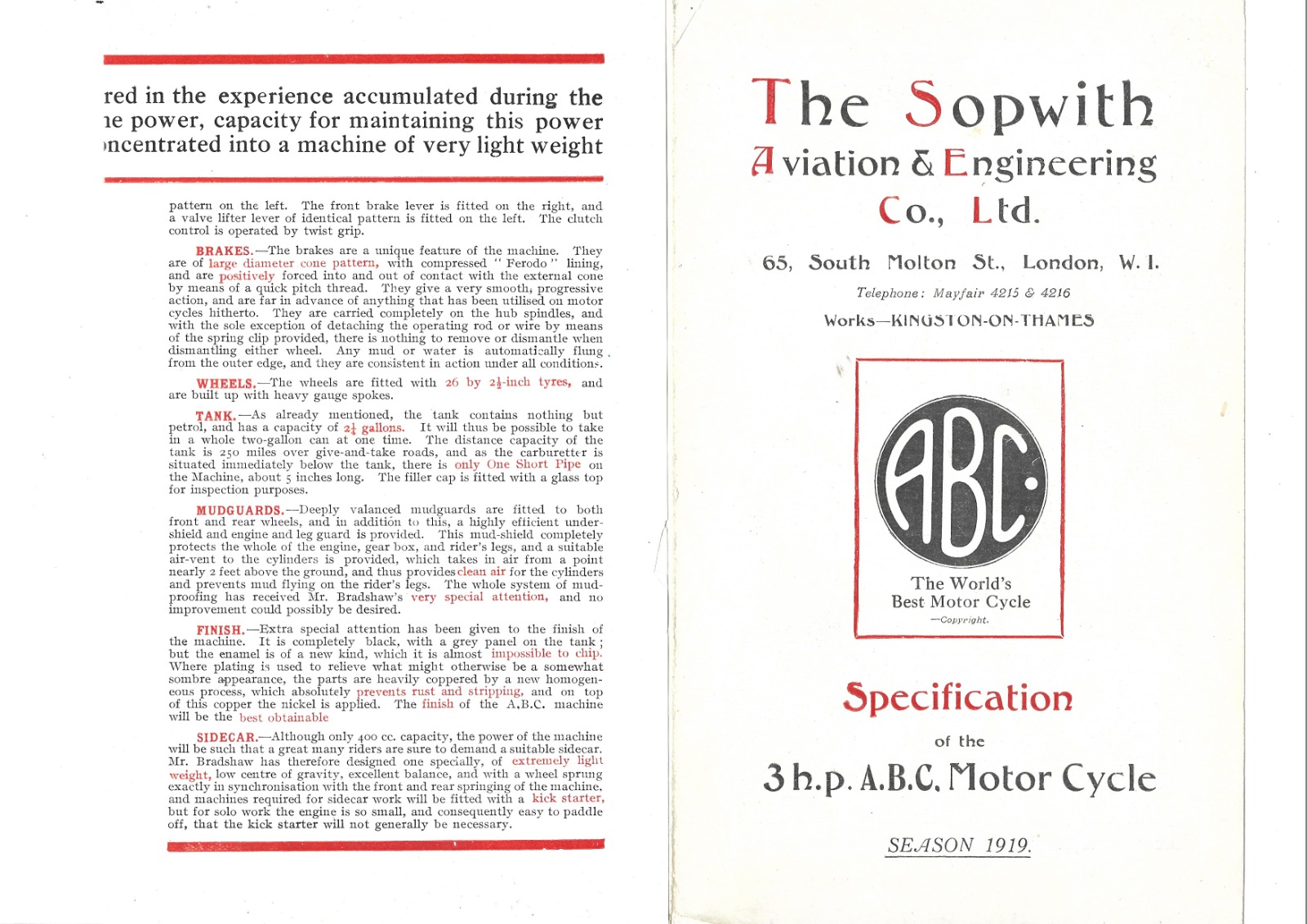- Posts: 173
The Colours of Sopwith
- Paul
- Topic Author
- Offline
Less
More
3 years 2 weeks ago #1422
by Paul
The Colours of Sopwith was created by Paul
Controversy still exists concerning the colour of the paint with which Sopwiths left their factory, although the consensus is that it was somewhere between "charcoal-grey" and "soot-black".
There is another lack of agreement over the surface-finish of this paint: "eggshell", "satin", and "gloss" are three contenders for acceptance on this.
The two contemporary references I have presented here don't help too much, being in less than total agreement with each other (See 'Finishes').
The youngest original paint is now more than a century old, but surely somewhere, tucked away in a protected corner of an unmolested frame-bracket or similar, is a flake or two of the Authentic Substance, that could authoritatively settle the issue for ever.
A minor matter is the infill-colour of the tank badges: nowhere have I come across any official mention of this, and until I do, mine will continue to be "fire-engine red": very smart!
There is another lack of agreement over the surface-finish of this paint: "eggshell", "satin", and "gloss" are three contenders for acceptance on this.
The two contemporary references I have presented here don't help too much, being in less than total agreement with each other (See 'Finishes').
The youngest original paint is now more than a century old, but surely somewhere, tucked away in a protected corner of an unmolested frame-bracket or similar, is a flake or two of the Authentic Substance, that could authoritatively settle the issue for ever.
A minor matter is the infill-colour of the tank badges: nowhere have I come across any official mention of this, and until I do, mine will continue to be "fire-engine red": very smart!
Please Log in or Create an account to join the conversation.
- gioorl
-

- Offline
Less
More
- Posts: 144
3 years 2 weeks ago #1423
by gioorl
Replied by gioorl on topic The Colours of Sopwith
Interesting topic.
In computer terms, "gunmetal black" is called #16181D (not to be confused with gunmetal #2C2A35) and can be seen here: https://www.color-name.com/gunmetal-black.color
This is certainly different than the 1920 version of gunmetal black but it might not have changed by much.
"Gunmetal" itself is slightly different as confirmed by Dictionary.com which defines it in four ways:
1. any of various alloys or metallic substances with a dark gray or blackish color or finish, used for chains, belt buckles, etc.
2. also called gunmetal gray a dark gray with bluish or purplish tinge.
3. a bronze formerly much used for cannon.
4. an alloy of 88 percent copper, 10 percent tin, and 2 percent zinc, cast or machined for use in valves, gears, and other parts.
In computer terms, "gunmetal black" is called #16181D (not to be confused with gunmetal #2C2A35) and can be seen here: https://www.color-name.com/gunmetal-black.color
This is certainly different than the 1920 version of gunmetal black but it might not have changed by much.
"Gunmetal" itself is slightly different as confirmed by Dictionary.com which defines it in four ways:
1. any of various alloys or metallic substances with a dark gray or blackish color or finish, used for chains, belt buckles, etc.
2. also called gunmetal gray a dark gray with bluish or purplish tinge.
3. a bronze formerly much used for cannon.
4. an alloy of 88 percent copper, 10 percent tin, and 2 percent zinc, cast or machined for use in valves, gears, and other parts.
Please Log in or Create an account to join the conversation.
- David
- Offline
Less
More
- Posts: 3
3 years 1 week ago #1435
by David
Replied by David on topic The Colours of Sopwith
I have an original Advertisement Supplement to ''The Motorcycle'' from The Sopwith Aviation & Engineering Co. Ltd.. It has four pages with two extracts from the Motorcycle on ''what the Technical press think'' dated March 18th and March 20th 1919 as well as an illustrated double page. At the bottom of this page under the heading ''General'', it says that the Finish is gun-metal black enamel (chip proof) on all parts, including hubs, springs, and handle-bars. Plating reduced to a minimum, but where it is used, parts are heavily coppered before being nickelled.
My father always spoke of the machine he had in the early 1920s as being a dull, slightly grey black colour, which he also called gun-metal. I have a few old clips and brackets which could be in original paint. I will try a little T- Cut on them and see if they look different to ordinary black!.
My father always spoke of the machine he had in the early 1920s as being a dull, slightly grey black colour, which he also called gun-metal. I have a few old clips and brackets which could be in original paint. I will try a little T- Cut on them and see if they look different to ordinary black!.
Please Log in or Create an account to join the conversation.
- dhales
- Offline
Less
More
- Posts: 11
3 years 5 days ago #1440
by dhales
Replied by dhales on topic The Colours of Sopwith
I was interested to see some recent correspondence regarding that old thorny problem of the colour of the 398cc motorcycles. When I collected one of my bikes from south of Croydon, the owner who had run Jarvis' of Wimbledon said "you may as well take this lot", pointing to rows of tins on his garage shelf. They turned out to be what was left of the spares for the 398cc machines that Jarvis' once stocked. Amongst them were some baffle plates that fitted into the forward facing leg shields that could be raised to let more air to the cylinders, and one of them was in the original paint finish. I regret selling the last pair to someone who needed them for their restoration, but from memory the finish was not black, but a darkish charcoal with a hint of blue, rather like blued steel. It had a slightly grainy sheen and was not gloss, but then it was also some 50 years old at the time. Plenty of people have seen reference to the original colour in the maker's brochure, and attempted to replicate the colour. I cannot say I ever remember seeing one that looked like the original part that I once had, which is why gloss black is such an easy choice, and one that everyone can obtain with ease.
Please Log in or Create an account to join the conversation.
- Roger
- Offline
Less
More
- Posts: 54
3 years 4 days ago - 3 years 4 days ago #1441
by Roger
Replied by Roger on topic The Colours of Sopwith
Perhaps the real question is the true origin of gunmetal black when appied to iron rather than a bronze alloy used to manufacture cannons. I still have a bottle of a solution of selenium dioxide used for cold bluing of springs. This sold to provide a black corrosion resistant surface coating on gun barrels although the original black magnetite surface created by a hot process. The hot process resultes in a non gloss dark grey finish which sounds very much like the appearance of the coating on ABC components.
I'm not sure that this answers the question of the paint used in the early 1920s which would have been a coach enamel as cellulose wasn't in common use until the mid 1920s. Morris introduced sprayed cellulose finishes in its production lines in 1926 and up to that time it was hand painted.
I'm not sure that this answers the question of the paint used in the early 1920s which would have been a coach enamel as cellulose wasn't in common use until the mid 1920s. Morris introduced sprayed cellulose finishes in its production lines in 1926 and up to that time it was hand painted.
Last edit: 3 years 4 days ago by Roger.
Please Log in or Create an account to join the conversation.



